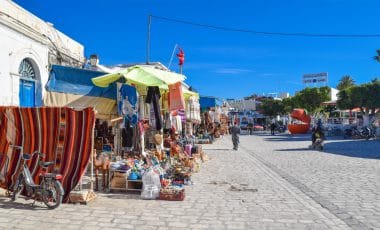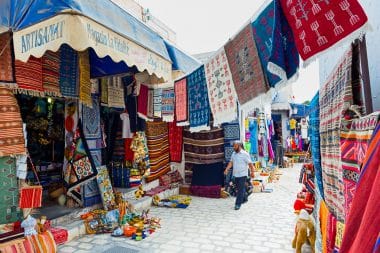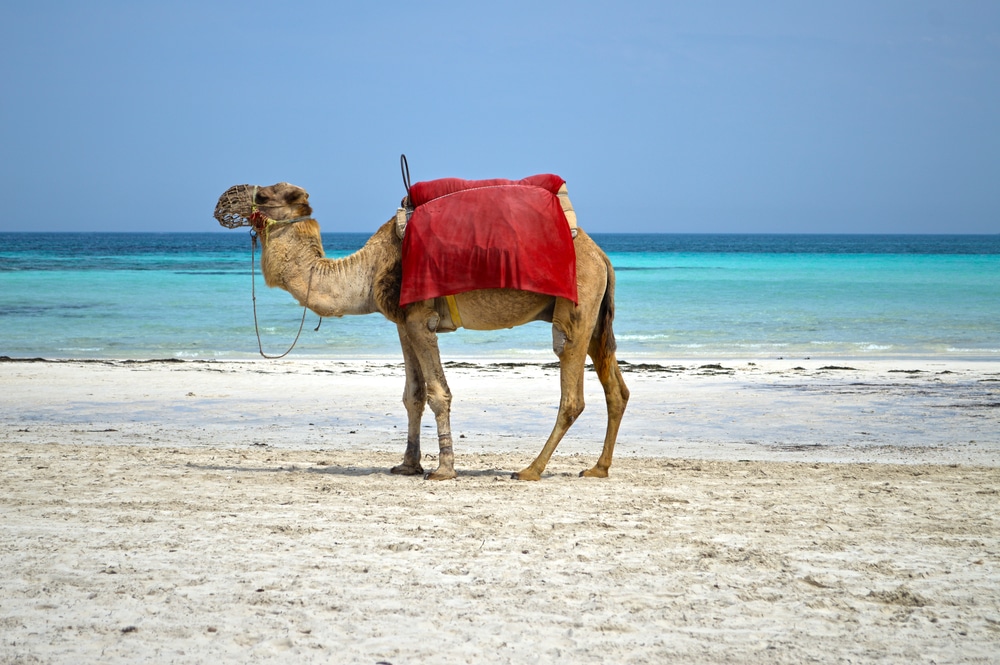If you were to ask the sun about one of its favourite destinations for a successful holiday, it wouldn’t have to think twice: “Djerba.” More than 300 days a year, she takes time for the largest island in North Africa to pamper it with its warm rays. She knows every corner and every sight of the 514 square kilometre island on the east coast of Tunisia, which is a lively and varied home for around 164,000 inhabitants. You would have to be a sun or a vacationer.
La Douce – The gentle island of hospitality
The flight from Germany to a dream vacation takes about three hours. Already on the way, you dream of friendly and child-loving Tunisians, look forward to their open and always friendly hospitality and to the simple but holiday-intensive island life.

Whether Houmt-Souk, the lively island capital, or just about any other place on Djerba – everywhere holidaymakers meet donkey carts, cars, cyclists or pedestrians on the shopping route to the market. Typical are women who carry their purchases home in a basket on their heads.
If Berlin is always worth a visit, Houmt-Souk and its old town certainly are. The bazaar is particularly recommended, although the offers of the shops in narrow, partly covered alleys are almost exclusively tailored to tourists: carpets, clothes, shoes, brass and silver art as well as leather goods determine the picture in the environment of eloquent traders. In general, the largest city in Djerba is a mixture of the Thousand and One Nights and European-modern echoes with typical oriental influences.
Djerba – The will to discover is in demand
Snow-white houses, ornate wooden doors and blue shutters are sure to be remembered as long as olive groves on the way to the port city of El May. Shortly before, in Midoun, it is worth stopping to see the underground oil mill there. Speaking of watching. While there are over 100 mosques on the island, most remain off-limits to vacationers. Better is a detour to the pottery village of Guellala, beautifully laid out on a hill. Souvenir holidaymakers will find, for example, small amphorae here, in which rainwater used to be collected.
Water, beach and pirate games
Djerba is the island for package tourists and the tourist strongholds on the east coast of the island are perfectly adapted to them. The northeastern coastal strip makes children’s eyes shine and makes the hearts of adults beat faster. This is due to the fine sandy and well-kept sandy beaches, which invite you to sunbathe as well as to build sandcastles. A jump into the crystal-clear water of the Mediterranean promises to cool off. Keyword water. Above and below the water’s surface, Djerba is bursting with sports facilities: diving, 9-hole golf, horseback riding, quad and jeep tours, surfing or sailing… or pirate trips in ancient boats with the destination of the six-kilometre-long Flamingo Peninsula.
As if that were all there is to it…
“What have you looked at in Djerba?” holidaymakers at home are often asked. And they are already starting to report. Via the Roman dam, which connects the island with the mainland and supplies it with fresh water. About the picturesque ruins of the fortress near El Kantara, which they could only reach with all-terrain cars and only at low tide. Or a visit to the Bordj-el-Kebir fortress in Houmt Souk.
They tell of the street art project in the village of Erriadh, very close to Djerbahood, of its 150 artists and 250 murals. Of palm and pomegranate trees, of the sea and more, such as the great climate, their unforgettable beach holiday. Or from the trip to the market in Midoun, peppered with bazaar shops and modern shops where haggling is not allowed for once. And they don’t forget the town of Meninx on the south coast, the ancient city founded by the Phoenicians. Part of the headland hides its face below sea level.
Djerba for fine tasting palates

Red sauces and especially harissa are encountered by hungry people on the island at every turn. The cuisine is shaped by numerous cultures. The Greeks contribute wine and olives. The French brought their baguette recipes to the island, the Arabs their coffee and spices such as turmeric, cumin, ginger or saffron. Under Ottoman influence, aubergines and pies are served and the dough “brik” or its sweet pastries are considered sought-after desserts. And who doesn’t know it, the national dish couscous from Berber origin.
Fresh fish dishes are neglected due to their high prices. In restaurants, however, fish does not have to be dispensed with, they are often served grilled. Favorites include sea bream, sea bass and grouper.
Again and again, lamb, less mutton, chicken or beef appear on the menus. And what about pig offers? The animals are considered unclean in Islamic countries, are usually reserved for foreign guests and are imported especially for this purpose.
In small rustic restaurants, the serving of alcohol is restricted, and again it is mostly tourists who order a Chardonnay, Cabernet Sauvignon or Merlot. The grape varieties arrive in Djerba from France , where they are cultivated and finally find their way into the glasses as dry wines.
As is well known, hunger comes with food. The stomach is opened by appetizers, usually filled with fish or meat, they are called “doigts de Fatma”. And for dessert, there is usually something sweet, along with green tea, mint, pistachios or almonds. Its name: “thé à la menthe”. However, cheese is and remains a matter of luck.
Result:
The sun has made a good choice with Djerba. And tourists from all over the world are likely to agree with her. This was impressively demonstrated by around 8.3 million Djerba guests last year. This means that the holiday island is back on the big tourist stage. In the spirit of 1001 Nights, of sun, palm trees and sea.


